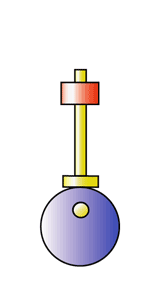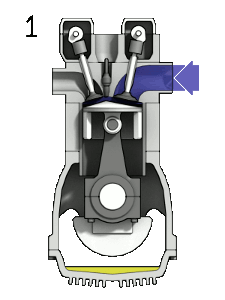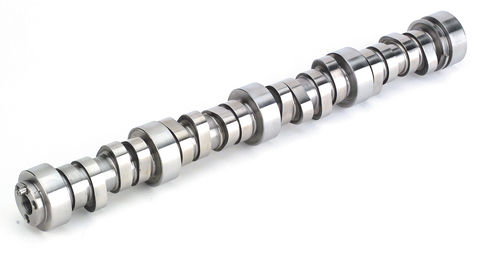Camshaft

A camshaft is a rod which rotates and slides against a piece of machinery in order to turn rotational motion into linear motion. This change of motion is accomplished by the camshaft moving further and closer from the axis of rotation as the camshaft is pushed by the machinery.[2] These moving pieces of the shaft are the cams. The linear distance moved is called the 'throw' and can be seen in Figure 1.
A camshaft on an internal combustion heat engine is a device that controls both the input of fuel and the expulsion of exhaust fumes. It consists of several radial cams, each displacing intake or exhaust valves. This camshaft is connected to the crankshaft via belt, chain or gears. This ensures consistent timing of the valves in relation to the motion of the pistons.[3]

The function of a camshaft is dependent on how a valve works and the function of the cam itself. A valve on a cylinder head consists of two basic parts, a stem and a head (see Figure 2). The head plugs the nozzle that allows fuel intake or exhaust flow and requires linear motion.[5] A cam, in its simplest definition, is a mechanical link that converts rotational motion into linear motion, or vice versa.[2] The cams on a camshaft achieve this displacement by the rotation of a radial pattern, and a follower which moves perpendicular to the rotational axis. The cam pattern on a camshaft is non-circular with a single lobe. The follower matches the displacement of the cam as it rotates. This displacement is then translated to the stem of the valve, allowing head to rise as the lobes of the cam pass through the follower.[5]
Since an automotive engine has several pistons like the piston in Figure 2, a single cam is insufficient for all of these pistons. An entire rod covered with cams must be used. This is the camshaft seen in Figure 3. Note that the precise placement of the cams along the shaft allow for precise timing of the relative valves opening and closing. This precise timing is needed since a car engine is firing at thousands of RPM.[3] Insuring the timing is proper in a car engine is one of the simpler ways to save money and energy.

For Further Reading
- Cam
- Reciprocating engine
- Internal combustion engine
- Rotational energy
- Gasoline engine
- Or explore a random page
References
- ↑ MsC Technology. (2011). Eccentric Cam [Online]. Available: http://msc-technology.wikispaces.com/Mechanical+Design#Cams
- ↑ 2.0 2.1 MsC Technology. (2011). Mechanical Design [Online]. Available http://msc-technology.wikispaces.com/Mechanical+Design#Cams
- ↑ 3.0 3.1 Engine Basics. (2009). Understanding Camshafts [Online]. Available: http://www.enginebasics.com/Engine%20Basics%20Root%20Folder/Basic%20Camshaft%20Understanding.html
- ↑ Zephyris. (2010). 4 Stroke Engine [Online]. Avaliable: http://en.wikipedia.org/wiki/Internal_combustion_engine#mediaviewer/File:4StrokeEngine_Ortho_3D_Small.gif
- ↑ 5.0 5.1 D. Fuhller. (2014). Camshaft FAQs: What is Lobe Separation? What are Intake and Exhaust Centerlines? (And More) [Online]. Available:http://www.onallcylinders.com/2014/02/07/camshaft-faqs-lobe-separation-intake-exhaust-centerlines/
- ↑ D. Fuller. (2014). Camshaft [Online]. Available: http://www.onallcylinders.com/2014/02/07/camshaft-faqs-lobe-separation-intake-exhaust-centerlines/

